What Temperature is Too Hot for Succulents? A Guide to Optimal Temperature Conditions

Succulents are known for their ability to withstand hot weather, but what temperature is too hot for these resilient plants?
While succulents are generally hardy and can tolerate a wide range of temperatures, extreme heat isn’t good for them. Extreme heat can cause succulents to become dehydrated, wilt, and even die if not properly cared for.

What temperature is too hot for succulents?
Most succulents can tolerate temperatures between 40°F and 90°F for extended periods, but extreme temperatures outside of this range can be damaging. Succulents that are native to colder climates, such as Sempervivum and Sedum, can tolerate temperatures as low as -20°F, while those from hotter climates, such as Agave and Aloe, can tolerate temperatures up to 120°F.
Here’s what you need to know about what temperature is too hot for succulents and how to protect them from extreme heat. Learn about the signs of heat stress in succulents so you can rescue them before it’s too late, (or stop worrying because they’re fine) and what you can do if your succulents have gotten too much sun.
If you’re curious about succulent temperature tolerance, you may also want to bookmark this complete guide to caring for any succulent, indoors or out.
Worried about how your succulents will do in cold temperatures? Here’s a guide to succulent winter care.
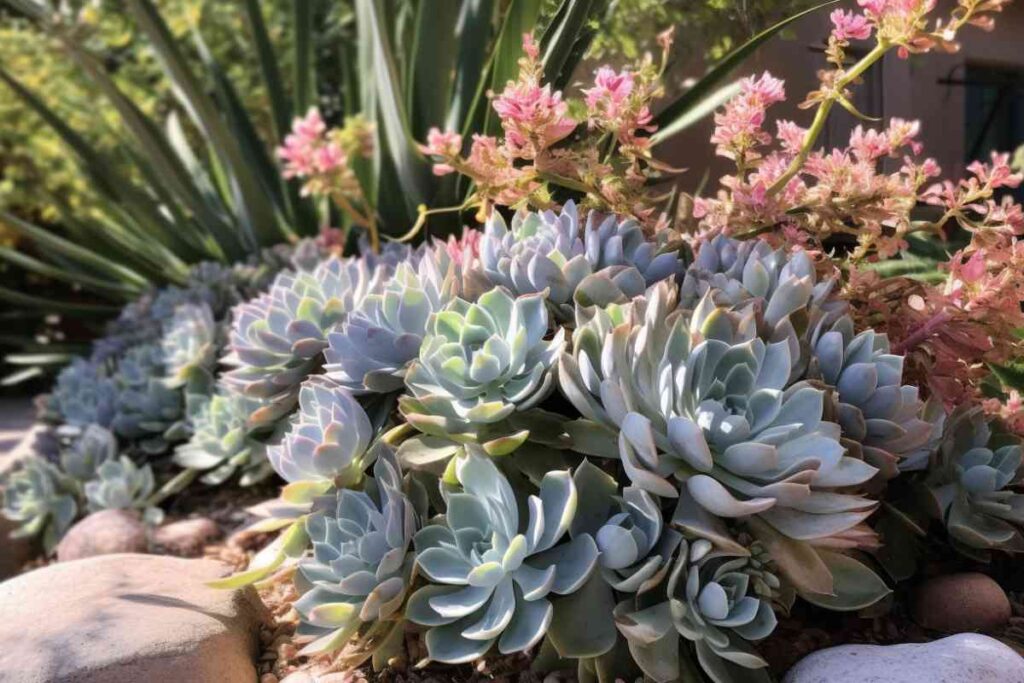
Ideal Temperature for Succulent Growth
The optimal temperature range for succulents is between 60-80°F (15-27°C) during the day and 50-70°F (10-20°C) at night. Many succulents can tolerate higher temperatures during the summer months and colder during winter months as long as they are provided with adequate shelter and water.
The Impact of High Temperatures on Succulents
When succulents are exposed to high temperatures, they may wilt, drop leaves, become sunburned, or slow growth. In extreme cases, succulents may even start to shed leaves or stop growing altogether, and ultimately die.
What is Sunburn in Succulents?
Sunburn is a common problem that can occur when succulents are exposed to high temperatures and intense sunlight. Sunburned succulents may develop brown or black spots on their leaves, and their overall appearance may become discolored or distorted.
How to Protect Indoor Succulents from High Temperatures
Keeping succulents at the ideal temperature is MUCH easier with indoor succulents than outdoor ones, but it can still be easy to make mistakes. Here are the essentials to keep your indoor succulents safe from excessive heat.

- Placement: Choose a location for your indoor succulents where they can receive the right amount of light without being exposed to excessive heat. Place them near windows or in areas with bright, indirect sunlight, but avoid placing them directly in the path of intense sunlight, such as right next to south-facing windows during the hottest parts of the day. Avoid placing succulents near heat sources like radiators, heating vents, or electronics that generate heat.
- Temperature Monitoring: Keep an eye on the ambient temperature near your succulents so it stays within the optimal range for your specific succulent species. Use a thermometer to monitor the temperature near your succulents’ growing area. Every home has microclimates, so the area around your succulents may be a very different temperature than what you central AC thermometer says.
- Air Circulation: Provide adequate air circulation around your indoor succulents. Stagnant, hot air can contribute to heat buildup. Place fans or open windows to promote airflow and help dissipate heat and create a more favorable microclimate for your succulents.
- Watering Practices: Adjust your watering routine during hot periods to prevent excessive heat stress. Succulents require more frequent watering in hot weather to compensate for increased evaporation, but be cautious not to overwater. Follow proper watering techniques for succulents, allowing the soil to dry out between waterings to prevent root rot.
- Shade or Filtered Light: If your indoor succulents are consistently exposed to intense sunlight, consider providing them with some shade or filtered light. You can use sheer curtains, blinds, or apply a thin shade cloth to diffuse the sunlight. This will help reduce the intensity of the light and minimize the risk of overheating.
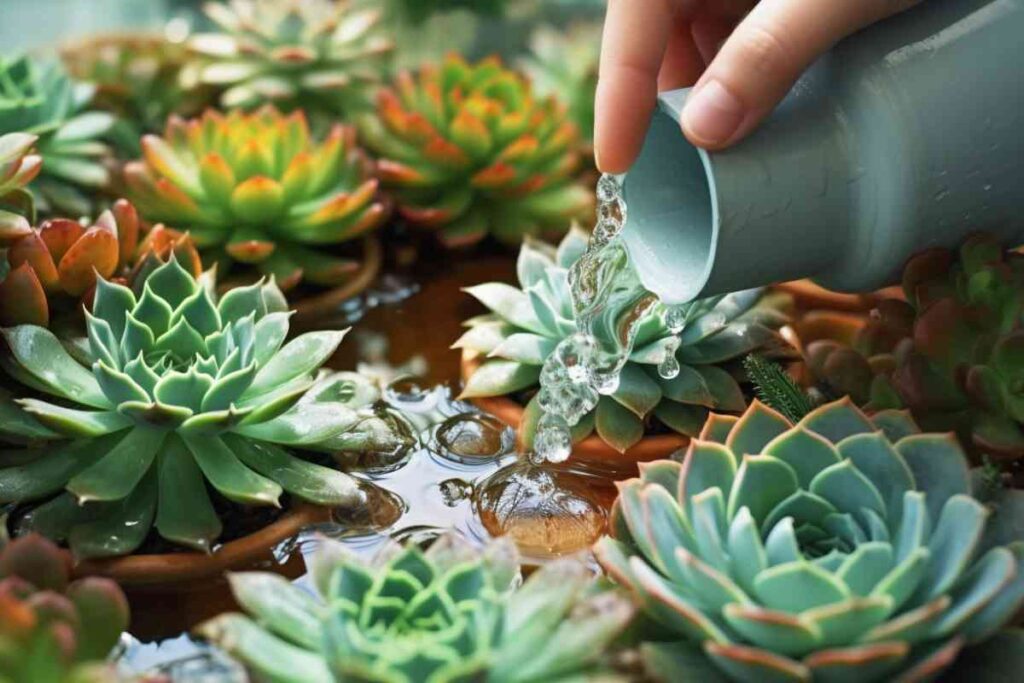
Try Bottom Watering Indoor Succulents
Bottom watering promotes healthier root growth by encouraging roots to grow downward in search of water. This helps establish a strong root system and enhances the plant’s overall stability.
Bottom watering also prevents the leaves of succulents from getting wet, reducing the risk of fungal diseases and rot. It also helps prevent water from accumulating in the rosettes of certain succulents, which can lead to issues like crown rot.
How to Protect Outdoor Succulents in Hot Weather
If you live in an area where the temperature rises above 90°F (32°C), you need to take precautions to protect your succulents. Many people use these methods through the summer but not in the winter.
Using Shade Cloth for Succulent Protection
One of the best ways to protect your succulents from the sun’s intense heat is to use shade cloth. Shade cloth is a breathable fabric that provides shade and reduces the amount of heat that reaches your plants. It comes in different densities, so you can choose the right level of protection for your succulents.
When using shade cloth, make sure to cover the plants completely, including the sides of the pot. This will help to keep the temperature down and prevent sunburn. Be sure to remove the shade cloth at night to allow the plants to breathe.

Choosing the Right Pot for Heat Tolerance
Choosing the right pot for your succulents is essential to their survival in hot weather. Clay pots are a good option because they are porous and allow for air circulation, which helps to keep the soil cool. Plastic pots are not recommended because they can trap heat and cause the soil to dry out quickly.
If you are planting succulents in a hot area, consider using a larger pot. Larger pots can hold more soil, which helps to insulate the roots and keep them cool.
Mulch Succulents to Keep Roots Cool
Mulch acts as a protective layer that helps retain moisture in the soil. In hot temperatures, the soil quickly dries out, leading to dehydration and stress in succulents.
By applying a layer of mulch around the base of the plants, you can reduce evaporation and keep moisture in the soil longer. Mulch also acts as insulation for the soil, moderating temperature fluctuations.
High temperatures can damage sensitive roots. A layer of mulch regulates soil temperature, keeping it cooler and more stable.
Weeds compete with succulents for water and nutrients, depriving them of essential resources. Mulch creates a barrier that inhibits weed growth around succulents, enabling all of the water and nutrients to go to your plants.
When mulching around succulents, it’s important to use materials that allow for adequate airflow and drainage, such as gravel, pebbles, or sand. Avoid using dense or moisture-absorbing organic mulches like wood mulch that can retain too much water and potentially cause root rot.
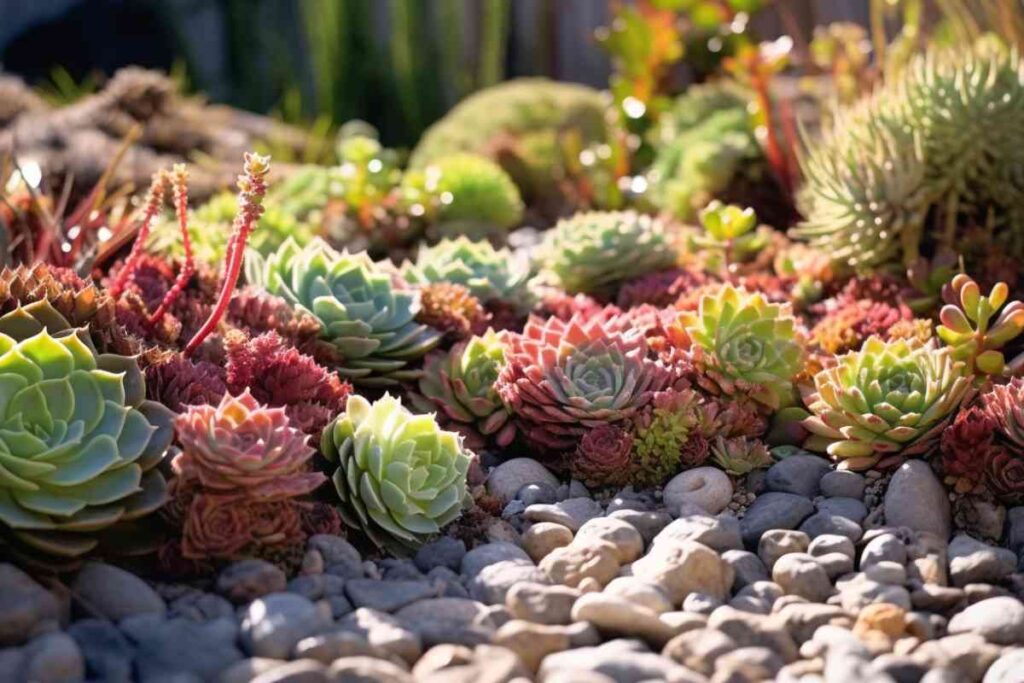
Proper Watering Techniques in Hot Weather
Proper watering techniques are crucial to the survival of succulents in hot weather. Succulents are adapted to dry conditions, but they need more water to survive when it’s very hot. During hot weather, it’s essential to water your succulents deeply and less frequently. This will help to prevent the soil from drying out too quickly.
To water your succulents properly, wait until the soil is completely dry before watering. Then, water the plant until the water runs out of the drainage holes or saturates the ground around the succulent. Be sure to allow the soil to dry out completely before watering again.
Good watering may be the most crucial element to getting succulents through hot weather, so I’m going to spend a little bit of extra time on it here.
Try a Soaker Hose
Succulents have shallow root systems that spread wide rather than deep. A soaker hose delivers water directly to the soil surface, allowing it to slowly seep into the soil and reach the roots effectively, encouraging succulents to develop deep root systems. This ensures efficient water absorption and minimizes water waste through evaporation or runoff.
Succulents are susceptible to rot and fungal diseases when water accumulates on their leaves. By delivering water directly to the soil, a soaker hose minimizes contact with the foliage, reducing the risk of diseases caused by excessive moisture.
Using a soaker hose reduces water wastage compared to methods like overhead watering or using a sprinkler that spray water into the air, where it evaporates. Instead, the water is applied directly to the root zone, minimizing evaporation and ensuring that it reaches the plants where it is needed most. This promotes efficient water usage and conservation.
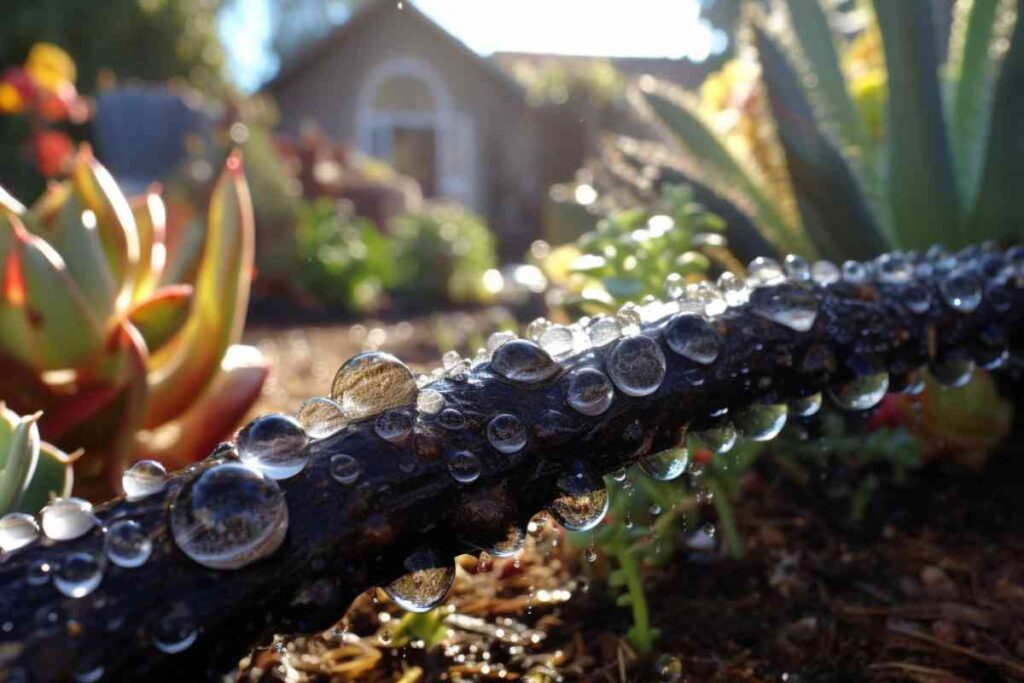
Sprinklers can Work to Cool Succulents Too
Watering succulents with a sprinkler in extreme heat can be challenging, as succulents prefer dry conditions and are susceptible to root rot and fungal diseases caused by excessive moisture. Furthermore, water sprayed out by sprinklers in high temperatures has a very high evaporation rate.
I firmly believe that a soaker hose is the best way to water succulents in hot weather (or any weather). That said, sprinklers are much more convenient for many people, so I’ll share my best tips here.
- Water in the Morning: Water your succulents with a sprinkler early in the morning to take advantage of cooler temperatures and lower evaporation rates. This allows the foliage and soil surface to dry out relatively quickly, reducing the chances of fungal growth.
- Adjust the Sprinkler: Position the sprinkler head in a way that avoids direct water contact with the succulent foliage. Instead, focus on watering the soil around the plants. This helps prevent water from pooling on the leaves, minimizing the risk of diseases.
- Water Deeply and Infrequently: Rather than frequent light watering, provide a deep soaking to mimic natural rainfall. This encourages succulents to develop a robust root system that can better withstand heat and drought. Water deeply but less frequently, allowing the soil to dry out completely between waterings.

Is Your Succulent Too Hot? Decision Tree
- Is the succulent showing signs of sunburn, such as brown or yellow patches on its leaves?
- Yes: The succulent is likely getting too much direct sunlight.
- No: Move to the next question.
- Are the leaves of the succulent becoming pale or bleached in color?
- Yes: The succulent may be receiving excessive sunlight.
- No: Move to the next question.
- Is the succulent becoming leggy or stretched out, with elongated stems and widely spaced leaves?
- Yes: This is a sign of etiolation, which can occur when a succulent is not receiving enough light. It may not be getting too much sun.
- No: Move to the next question.
- Is the succulent showing signs of dehydration, such as shriveled or wrinkled leaves?
- Yes: The succulent may not be getting enough water rather than too much sun.
- No: Move to the next question.
- Are the leaves of the succulent becoming overly thick or compact, possibly with a red or purple tinge?
- Yes: This could indicate that the succulent is receiving excessive sunlight and is trying to protect itself.
- No: The succulent is likely not getting too much sun.

Which is Worse for Succulents: Too Hot or Too Cold?
Most succulents have evolved to thrive in arid and warm environments, such as desert regions. They have developed specialized adaptations to store water in their leaves, stems, or roots, which helps them survive in dry conditions. However, these adaptations make them susceptible to damage from cold temperatures.
When exposed to freezing temperatures, the water stored in succulents’ cells freeze and expand, leading to cell rupture and tissue damage. This causes the succulent to wilt, discolor, or even die.
While some succulents have developed mechanisms to tolerate cold temperatures to some extent, the majority are not equipped to withstand prolonged exposure to freezing conditions.
What is Sun Stress in Succulents?
Sun stress in succulents is a natural response to intense sunlight. It doesn’t always indicate that a succulent is getting too much sun; rather, it means the plant is experiencing a high level of light exposure. This stress response is a survival mechanism employed by succulents to protect themselves from excessive heat.
One common sign of sun stress is the development of vibrant colors in succulents. Many species change their leaf color to shades of red, purple, or orange when exposed to bright sunlight.

This phenomenon, known as sun-induced coloration, serves as a protective mechanism against excessive light and UV radiation. The pigments responsible for these color changes help to absorb and dissipate the excess energy from the sun, reducing the risk of sunburn and damage to the plant’s tissues.
These color changes are not always an indication that the succulent needs more shade or is receiving too much sun. In fact, for certain species, such as some
Echeveria or Sedum varieties, intense sun exposure is necessary to bring out their vibrant colors and promote healthy growth. These succulents are naturally adapted to thrive in bright sunlight and can tolerate high light levels without adverse effects.
I thought my Flapjack Kalanchoe was BORING until I gave it more sun, and the edges of the leaves turned bright red.

However, it’s crucial to monitor the overall health of the succulent and assess if there are any signs of damage or stress beyond the natural color changes.
If the plant starts to exhibit symptoms like sunburn (brown or yellow patches), shriveled or wilted leaves, or excessive drying, it may be getting too much direct sunlight and needs some protection or shade.
The key is to find the right balance for your specific succulent species. Observe how your succulent responds to different light conditions and make adjustments accordingly.
Succulents that Change Color in High Temperatures
Many succulent species exhibit color changes when they experience sun stress. Here are some commonly known succulents that are known to change color in response to intense sunlight:
- Echeveria spp.: Various Echeveria species, such as Echeveria ‘Lola’ or Echeveria agavoides, can develop vibrant red, pink, or purple hues on their leaf margins or tips when exposed to bright sun.
- Sedum spp.: Several Sedum varieties, including Sedum adolphii or Sedum nussbaumerianum, may turn shades of red, orange, or copper in response to intense sunlight.
- Graptoveria spp.: Graptoveria ‘Fred Ives’ and other Graptoveria hybrids often display stunning color changes, ranging from pink to deep burgundy, when exposed to bright light.
- Aeonium spp.: Some Aeonium species, such as Aeonium ‘Zwartkop’ or Aeonium arboreum ‘Atropurpureum’, exhibit dramatic color shifts, with their leaves transitioning from green to deep purple or almost black in strong sun.
- Kalanchoe spp.: Certain Kalanchoe varieties, like Kalanchoe thyrsiflora or Kalanchoe luciae (Paddle Plant), can develop reddish or purplish hues on their leaf edges when exposed to direct sunlight.
- Sempervivum spp.: Many Sempervivum cultivars, commonly known as Hens and Chicks, can display color changes, with their rosettes taking on shades of red, pink, or purple under intense light conditions.
Remember, these color changes are natural responses to sun exposure and often enhance the aesthetic appeal of the succulents. However, it’s important to monitor the overall health of the plant and provide appropriate care to ensure it is not experiencing excessive stress or damage from too much sunlight.
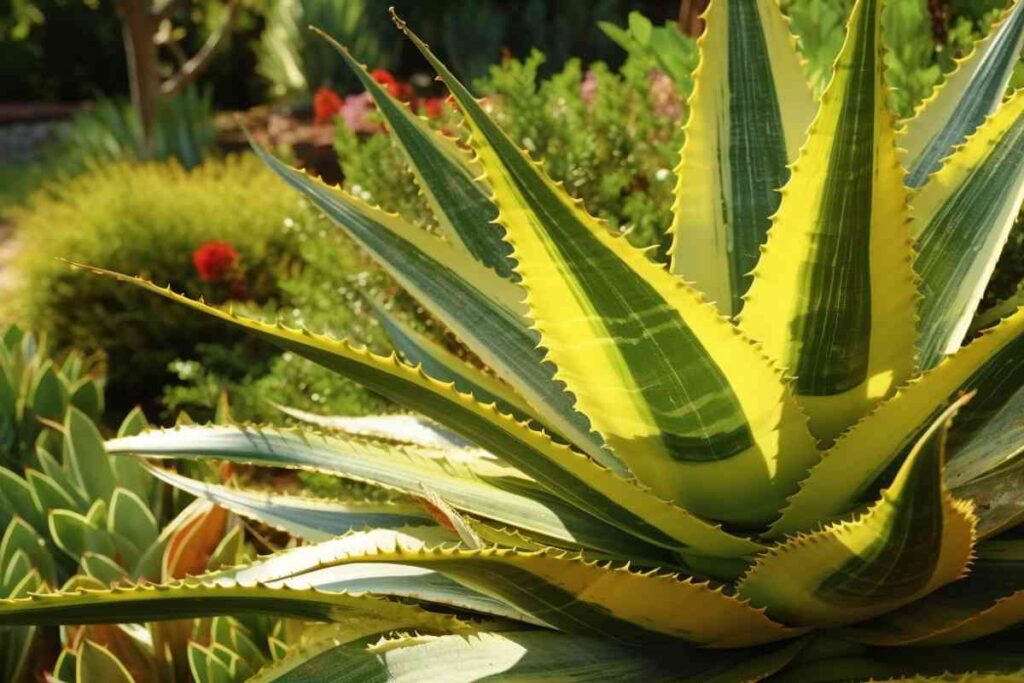
Succulents that can Handle High Temperatures
| Species | Temperature Tolerance | Description |
|---|---|---|
| Agave americana (Century Plant) | Up to 120°F (49°C) | Large succulent with rosettes of thick, spiky leaves. |
| Echeveria elegans (Mexican Snowball) | Up to 100°F (38°C) | Rosette-forming succulent with pale blue-green leaves. |
| Aloe vera | Up to 100°F (38°C) | Popular succulent with fleshy, serrated leaves known for its medicinal properties. |
| Sedum rubrotinctum (Jelly Bean Plant) | Up to 90°F (32°C) | Low-growing succulent with jelly bean-like leaves that change color in bright light. |
| Kalanchoe luciae (Flapjack Plant) | Up to 90°F (32°C) | Thick, paddle-shaped leaves with red margins that turn vibrant colors in full sun. |
| Crassula ovata (Jade Plant) | Up to 90°F (32°C) | Drought-tolerant succulent with fleshy leaves and tree-like growth habit. |
| Euphorbia tirucalli (Pencil Cactus) | Up to 100°F (38°C) | Thin, pencil-like branches with small leaves, turns red under stress. |
| Yucca filamentosa (Adam’s Needle) | Up to 90°F (32°C) | Sword-shaped leaves with tall flower spikes, highly adaptable to hot climates. |
| Opuntia engelmannii (Engelmann’s Prickly Pear) | Up to 110°F (43°C) | Paddle-shaped pads covered in spines, produces vibrant flowers and edible fruits. |
| Sempervivum tectorum (Common Houseleek) | Up to 90°F (32°C) | Rosette-forming succulent with fleshy leaves in various colors, often used in rock gardens. |
| Agave desmettiana (Smooth Agave) | Up to 100°F (38°C) | Large succulent with smooth, lance-shaped leaves forming a dramatic rosette. |
| Mammillaria elongata (Ladyfinger Cactus) | Up to 100°F (38°C) | Small cylindrical cactus with dense spines and pink flowers. |
| Senecio mandraliscae (Blue Chalksticks) | Up to 100°F (38°C) | Blue-gray succulent with cylindrical leaves, forms cascading trails. |
| Ferocactus pilosus (Mexican Lime Cactus) | Up to 110°F (43°C) | Barrel-shaped cactus covered in spines, with yellow or red flowers. |
| Echinocactus grusonii (Golden Barrel Cactus) | Up to 120°F (49°C) | Globular cactus with golden spines, slow-growing and long-lived. |
| Crassula muscosa (Watch Chain) | Up to 90°F (32°C) | Succulent with trailing stems covered in small, green leaves resembling a chain. |
| Agave parryi (Artichoke Agave) | Up to 100°F (38°C) | Compact succulent with gray-green leaves and spiky edges, resembles an artichoke. |
| Aeonium arboreum (Tree Aeonium) | Up to 90°F (32°C) | Tall succulent with rosettes of fleshy leaves on branching stems, can turn burgundy in full sun. |
| Sedum nussbaumerianum (Coppertone Stonecrop) | Up to 90°F (32°C) | Trailing succulent with coppery, jelly bean-shaped leaves, turns reddish under bright light. |
| Astrophytum asterias (Star Cactus) | Up to 100°F (38°C) | Globe-shaped cactus covered in white or yellow spines, has star-shaped patterns on the body. |

Conclusion
Succulents are among the best plants for high temperatures. By choosing your succulents wisely and following these care tips, you can be confident of a gorgeous garden despite the heat.
Which succulents should you choose? I’ve made a round up of the best succulents for hot sun here.
If you’ve been a bit overeager in protecting your succulents from the heat and ovewatered, they may have root rot. Learn how to save them.
Frequently Asked Questions
Can succulents live in 100 degree weather?
Yes, many succulents can survive in 100-degree weather. Succulents are well-adapted to arid environments and have developed mechanisms to withstand high temperatures and drought conditions. They have thick, fleshy leaves that store water, reducing their dependence on frequent watering. Additionally, succulents often have protective coatings or hairs on their leaves that help reduce water loss through evaporation. While they can tolerate high temperatures, it’s important to ensure they receive adequate shade and protection from intense afternoon sun to prevent sunburn. Proper watering practices and well-draining soil are also crucial for their survival in hot climates.
Can succulents be in full hot sun?
Most succulents are adapted to hot, sunny conditions and can thrive in full sun. However, some species may need to be acclimated to full sun gradually, especially if they have been grown indoors or in the shade.
How often should you water succulents in 100 degree weather?
In extremely hot weather, succulents may need to be watered more frequently than usual to prevent them from drying out. However, it is important not to overwater succulents, as this can cause root rot. A good rule of thumb is to water succulents when the soil is completely dry.
What temperature is bad for succulents?
Temperatures below freezing can be fatal to most succulent species, as their fleshy leaves are prone to freezing and bursting. On the other hand, sustained temperatures above 90 degrees Fahrenheit can cause damage to some succulent species.
When to bring succulents inside?
If you live in an area with extreme temperatures, it may be a good idea to bring your succulents inside during the hottest or coldest parts of the day. Additionally, if you notice your succulents starting to wilt or show signs of stress, it may be time to bring them inside.
Best succulents for full hot sun?
There are many succulent species that can thrive in full sun, including agave, aloe, and sedum. However, it is important to choose species that are adapted to your specific climate and growing conditions.
Succulents are generally hardy plants that can tolerate hot weather, but temperatures above 90 degrees Fahrenheit can cause damage to some succulent species. If you live in an area with extremely high temperatures, it is important to choose succulent species that are adapted to those conditions.
“}},{“@type”:”Question”,”name”:”Can succulents be in full hot sun?”,”acceptedAnswer”:{“@type”:”Answer”,”text”:”
Most succulents are adapted to hot, sunny conditions and can thrive in full sun. However, some species may need to be acclimated to full sun gradually, especially if they have been grown indoors or in the shade.
“}},{“@type”:”Question”,”name”:”How often should you water succulents in 100 degree weather?”,”acceptedAnswer”:{“@type”:”Answer”,”text”:”
In extremely hot weather, succulents may need to be watered more frequently than usual to prevent them from drying out. However, it is important not to overwater succulents, as this can cause root rot. A good rule of thumb is to water succulents when the soil is completely dry.
“}},{“@type”:”Question”,”name”:”What temperature is bad for succulents?”,”acceptedAnswer”:{“@type”:”Answer”,”text”:”
Temperatures below freezing can be fatal to most succulent species, as their fleshy leaves are prone to freezing and bursting. On the other hand, temperatures above 90 degrees Fahrenheit can cause damage to some succulent species.
“}},{“@type”:”Question”,”name”:”When to bring succulents inside?”,”acceptedAnswer”:{“@type”:”Answer”,”text”:”
If you live in an area with extreme temperatures, it may be a good idea to bring your succulents inside during the hottest or coldest parts of the day. Additionally, if you notice your succulents starting to wilt or show signs of stress, it may be time to bring them inside.
“}},{“@type”:”Question”,”name”:”Best succulents for full hot sun?”,”acceptedAnswer”:{“@type”:”Answer”,”text”:”
There are many succulent species that can thrive in full sun, including agave, aloe, and sedum. However, it is important to choose species that are adapted to your specific climate and growing conditions.
“}}]}



